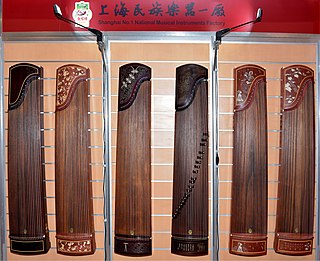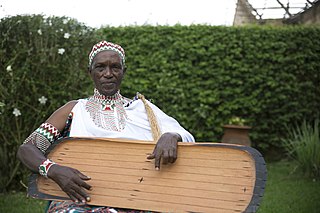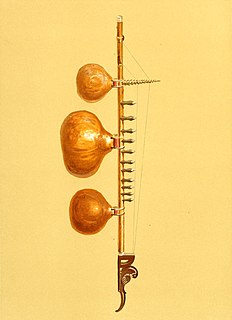
Zither is a class of stringed instruments. Historically, the name has been applied to any instrument of the psaltery family, or to an instrument consisting of many strings stretched across a thin, flat body. This article describes the latter variety.

The highly diverse and distinctive music of Madagascar has been shaped by the musical traditions of Southeast Asia, Africa, Arabia, England, France and the United States over time as indigenous people, immigrants, and colonists have made the island their home. Traditional instruments reflect these widespread origins: the mandoliny and kabosy owe their existence to the introduction of the guitar by early Arab or European seafarers, the ubiquitous djembe originated in mainland Africa and the valiha—the bamboo tube zither considered the national instrument of Madagascar—directly evolved from an earlier form of zither carried with the first Austronesian settlers on their outrigger canoes.

The geomungo or hyeongeum is a traditional Korean plucked zither with both bridges and frets. Geomungo is a representative stringed instrument made in Goguryeo before the 5th century. Scholars believe that the name refers to Goguryeo and translates to "Goguryeo zither" or that it refers to the colour and translates to "black crane zither".

The đàn bầu, also called độc huyền cầm is a Vietnamese stringed instrument, in the form of a monochord (one-string) zither.

The zheng or guzheng, is a Chinese plucked zither. The modern guzheng commonly has 21, 25 or 26 strings, is 64 inches (1.6 m) long, and is tuned in a major pentatonic scale. It has a large, resonant soundboard made from Paulownia wood . Other components are often made from other woods for structural or decorative reasons. Guzheng players often wear fingerpicks made from materials such as plastic, resin, tortoiseshell, or ivory on one or both hands.

The yazheng is a Chinese string instrument. It is a traditional zither similar to the guzheng but bowed by scraping with a sorghum stem dusted with resin, a horsehair bow, or a piece of forsythia wood. The musical instrument was popular in the Tang Dynasty, but is today little used except in the folk music of some parts of northern China, where it is called yaqin.

The đàn tranh or đàn thập lục is a plucked zither of Vietnam, based to the Chinese guzheng. The same root is also Japanese koto, the Korean gayageum and ajaeng, the Mongolian yatga, the Sundanese kacapi and the Kazakh jetigen. It has a long soundbox with the steel strings, movable bridges and tuning pegs positioned on its top.
Traditional Vietnamese musical instruments are the musical instruments used in the traditional and classical musics of Vietnam. They comprise a wide range of string, wind, and percussion instruments, used by both the Viet (Kinh) majority as well as the nation's ethnic minorities.

The Rhade or Ede are an Austronesian ethnic group of southern Vietnam.
The k'ni or Vietnamese mouth violin is a fiddle-like instrument used by the Jarai people in Vietnam. The term is the common word for fiddle in the Jarai language. It is a bowed chordophone which uses the musician's mouth as a resonator which enables the instrument to imitate certain qualities found in vocal music. Similar instruments are used among other tribal peoples of the Central Highlands, such as the Bahnar people.

The sasando, also called sasandu from Sandu or Sanu, is a tube zither, a harp-like traditional music string instrument native to Rote Island of East Nusa Tenggara, Indonesia.

Bamboo's natural hollow form makes it an obvious choice for many musical instruments.

The mvet is a stringed musical instrument, a type of stick zither, Hornbostel-Sachs (311) of the Fang people of Gabon, Cameroon, São Tomé and Equatorial Guinea. Somewhat resembling the Mande kora, but larger and simpler, it consists of a tubular stick of palm-raffia or bamboo, between one and two metres long, with usually three calabash resonators. A central vertical bridge divides four or five gut or metal strings, played both sides of the bridge.

The kong ring or gung treng is a Cambodian tube zither, in which a tube of bamboo is used as a resonator for stings that run along the outside of the tube, lengthwise. It has the same musical purpose as the "bossed gongs" and may substitute for them and accompany singing. Although it is a traditional instrument with a long history, it has been improved on in modern times. The kong ring is represented by similar instruments in other countries of South Asia and the Pacific.

The tube zither is a stringed musical instrument in which a tube functions both as an instrument's neck and its soundbox. As the neck, it holds strings taut and allows them to vibrate. As a soundbox or it modifies the sound and transfers it to the open air. The instruments are among the oldest of chordophones, being "a very early stage" in the development of chordophones, and predate some of the oldest chordophones, such as the Chinese Se, zithers built on a tube split in half. Most tube zithers are made of bamboo, played today in Madagascar, India, Southeast Asia and Taiwan. Tube zithers made from other materials have been found in Europe and the United States, made from materials such as cornstalks and cactus.

A raft zither is a group of single-cord tube zithers, connected together to form a "raft". Tube zithers use a tube as a platform to hold a string, raised with bridges.

Trough zithers are a group of African stringed instruments or chordophones whose members resemble wooden bowls, pans, platters, or shallow gutters with strings stretched across the opening. A type of zither, the instruments may be quiet, depending upon the shape of the bowl or string-holder. Sound is often amplified with the addition of a gourd resonator. Instruments have been classed into five different types, based on shape.

The kinnari vina is a historical veena, a tube zither with gourds attached to act as resonators and frets. It was played in India into the late 19th century and was documented by two European artists. The instrument dates back into medieval times and possibly as far back as 500 C.E. It is closely related to the Alapini Vina and Eka-tantri Vina, the instruments having coexisted in medieval times.

The eka-tantrī vīṇā was a medieval tube-zither veena in India, with a single string and one or more gourd resonators. The instrument became prominent in Indian music in about the 10th century C.E. as instruments of court music. Alongside the alapini vina and kinnari vina it replaced the harp-style veenas and lute-style veenas in sculpture. It was possibly a forerunner of the rudra vina. It shares its name with the modern single-string drone lute, the ektara.

The ālāpiṇī vīṇā was a medieval stick-zither veena in India, with a single string and a gourd resonator. Later forms added more strings. The instruments became prominent in Indian music after 500 C.E. as instruments of court music. Alongside the eka-tantri vina and kinnari vina it replaced the harp-style veenas and lute-style veenas. The instruments were used in Southeast Asia, both mainland and island nations, and were recorded in sculpture and relief sculpture.

















